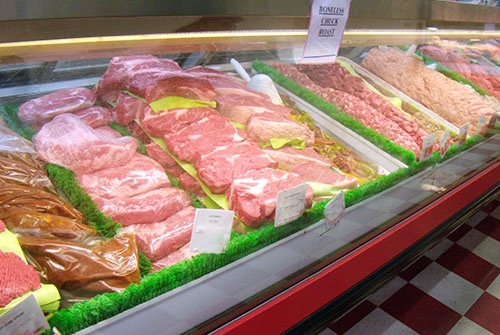Why Bagley Farms Meat Market Edwardsville IL Is the most effective Selection for Top Quality Meats
Why Bagley Farms Meat Market Edwardsville IL Is the most effective Selection for Top Quality Meats
Blog Article
Discover the Art of the Butcher's Cut in a Modern Meat Market
In the ever-evolving landscape of modern meat markets, the butcher's cut has actually transcended its typical origins, combining olden workmanship with contemporary techniques. What really establishes the modern-day butcher apart is their capability to build a deeper link between customers and the beginnings of their meat.
Development of Butchery Strategies

The mid-20th century saw butchery strategies additionally fine-tuned by scientific insights right into muscle mass biology and meat aging, improving both tenderness and preference. Innovations like vacuum packaging and refrigeration expanded item shelf-life, enabling butchers to diversify offerings and boost quality assurance. This period also noted the rise of customized devices, such as band saws and meat slicers, which enhanced precision and performance in meat processing.
Computerized systems currently assist in tracking pet provenance and optimizing cuts to satisfy details client choices. In addition, a revival in artisanal butchery has actually emerged, blending typical skills with contemporary expertise to cater to consumers seeking moral and sustainable meat options.

Comprehending Meat Cuts

Understanding the ins and outs of meat cuts is important for both butchers and customers looking for high quality and worth. Each cut comes from a different component of the animal, passing on distinct flavors, appearances, and food preparation techniques. Mastery of these distinctions not only enhances cooking experiences yet likewise optimizes the utility of each carcass. For butchers, precise cuts mirror ability and respect for the craft, making sure minimal waste and optimum return.
The primary groups of meat cuts consist of primitive, sub-primal, and retail cuts. Primal cuts, such as the loin, rib, and chuck, are the big sections at first separated from the carcass. Butchers after that damage these down additionally into sub-primal cuts, before finally creating retail cuts available to consumers, like ribeye or tenderloin. Each phase requires mindful attention to physiological framework and muscular tissue structure.
Comprehending muscular tissue composition is critical; muscles utilized much more regularly by the animal have a tendency to be harder and are best suited for slow food preparation approaches, while less-used muscles, like those found in the loin, are extra tender and ideal for cooking or roasting. Experience with these distinctions equips consumers to make enlightened selections, enhancing their cooking endeavors.
Picking Top Quality Meat
Selecting the right meat entails more than simply picking a visually enticing item from the screen. The art of picking high quality meat requires a critical eye and understanding of particular attributes that represent freshness and quality.
Secondly, take into consideration the marbling, which describes the white flecks of fat within the muscular tissue. Proper marbling is a vital sign of tenderness and taste, as it melts throughout cooking, boosting the meat's juiciness. Remember, greater marbling typically correlates with superior quality cuts, such as USDA Prime.
Structure is another essential element; meat needs to feel strong to the touch, not slimy or excessively soft. Additionally, be mindful of the scent. Fresh meat must have a clean, neutral odor, devoid of any type of sour or repulsive odors.
Combining Cuts With Food Preparation Techniques
Successfully combining cuts of meat with the suitable food preparation approaches is important for attaining optimal flavor and structure. view it Various cuts differ in inflammation, marbling, and connective tissue material, each calling for specific techniques to unlock their possibility. Tender cuts like filet mignon and ribeye, with their integral marbling, advantage from high-heat, quick-cooking methods such as grilling or pan-searing. These techniques improve the meat's all-natural tastes and make certain a juicy surface.
Conversely, tougher cuts like brisket and chuck roast are rich in collagen, which damages down right into jelly when cooked gradually. These cuts are excellent for braising or slow-moving roasting, permitting the meat to soften gradually and establish deep, complicated flavors. Cuts such as brief ribs and pork shoulder get on well with slow-cooking techniques, where extended cooking times transform their durable structures into this article succulent dishes.
Lamb shanks and oxtail, which call for extended cooking to tenderize, are ideal prospects for cooking or sluggish simmering. These approaches coax out rich, hearty tastes while maintaining dampness. By recognizing the unique features of each cut, cooks and home chefs alike can elevate their cooking developments, making certain each meal is both pleasing and unforgettable.
The Butcher's Role Today
Navigating the advancing landscape of the modern meat market, the butcher's duty today extends past plain preparation of cuts. Contemporary butchers are culinary craftsmens, educators, and advocates for lasting practices.
Along with crafting specific cuts, butchers now involve straight with customers, providing cooking advice and tailoring choices to match individual requirements and choices. Their know-how in meat aging, marbling, and flavor profiles equips customers to make enlightened decisions, improving their cooking experiences. This personalized service exemplifies the butcher's advancing role as a trusted advisor in the kitchen area.
Moreover, butchers are crucial in reducing waste, using entire pets to develop varied items such as sausages and supplies - bagley farms meat market edwardsville il. This comprehensive technique not just respects the animal however also straightens with contemporary sustainability goals. This way, the contemporary butcher personifies both practice and technology, adjusting to an ever-changing market while preserving the artistry and integrity of their craft

Final Thought
Proficiency in understanding diverse meat cuts and top quality indicators equips butchers to provide educated referrals, aligning particular cuts with optimal food preparation approaches. By honoring historical techniques while embracing contemporary demands, the butcher's duty remains important in today's Get the facts advanced meat market.
Report this page